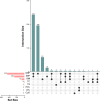Cardiovascular risk factors modulate the effect of brain imaging-derived phenotypes on ischaemic stroke risk
- PMID: 40395631
- PMCID: PMC12089767
- DOI: 10.1093/braincomms/fcaf183
Cardiovascular risk factors modulate the effect of brain imaging-derived phenotypes on ischaemic stroke risk
Abstract
Studies have shown that cardiovascular risk factors are closely related to the occurrence of stroke, especially ischaemic stroke, as they can lead to changes in brain structure and function. However, the role of cardiovascular risk factors-induced changes in brain structure and function in the development of ischaemic stroke has not been studied. The aim of this study is thus to explore the causal association among cardiovascular risk factors, brain phenotypes and ischaemic stroke by assessing Mendelian randomization. We used univariate Mendelian randomization to sequentially investigate the causal effects of the 12 most common cardiovascular risk factors on brain structure and 3935 brain imaging-derived phenotypes in the development of ischaemic stroke. We also examined the mediating effect of brain structure on blood pressure-induced ischaemic stroke using a multivariable Mendelian randomization test. We tested the reliability of our results using the Steiger test, heterogeneity test, horizontal pleiotropy test and leave-one-out method. We found that 8 of the 12 examined cardiovascular risk factors were associated with 538 brain imaging-derived phenotypes, and 9 of the 12 cardiovascular risk factors were associated with IS. The main cardiovascular risk factors associated with brain imaging-derived phenotypes and ischaemic stroke was blood pressure (systolic and diastolic), which can affect the occurrence of ischaemic stroke through 6 types of brain imaging-derived phenotypes. However, extrapolation of our findings to other ethnic groups is challenging, and the possibility of reverse causality cannot be completely ruled out. This study identifies the role of cardiovascular risk factors, especially blood pressure, in affecting brain structure and ischaemic stroke risk. The findings assist in early risk detection and enhance stroke prevention strategies, also hinting at non-vascular factors' involvement.
Keywords: Mendelian randomization; brain imaging-derived phenotypes; cardiovascular risk factors; ischaemic stroke.
© The Author(s) 2025. Published by Oxford University Press on behalf of the Guarantors of Brain.
Conflict of interest statement
The authors report no competing interests..
Figures






Similar articles
-
Use of Mendelian randomization to evaluate the effect of atrial fibrillation on cardiovascular diseases and cardiac death.ESC Heart Fail. 2023 Feb;10(1):628-636. doi: 10.1002/ehf2.14237. Epub 2022 Nov 20. ESC Heart Fail. 2023. PMID: 36404673 Free PMC article.
-
Causal associations of serum matrix metalloproteinase-8 level with ischaemic stroke and ischaemic stroke subtypes: a Mendelian randomization study.Eur J Neurol. 2021 Aug;28(8):2543-2551. doi: 10.1111/ene.14878. Epub 2021 May 14. Eur J Neurol. 2021. PMID: 33894037
-
Genetic analyses identify brain imaging-derived phenotypes associated with the risk of amyotrophic lateral sclerosis.Cereb Cortex. 2024 Jan 14;34(1):bhad496. doi: 10.1093/cercor/bhad496. Cereb Cortex. 2024. PMID: 38112636
-
Gut microbiome and risk of ischaemic stroke: a comprehensive Mendelian randomization study.Eur J Prev Cardiol. 2023 May 9;30(7):613-620. doi: 10.1093/eurjpc/zwad052. Eur J Prev Cardiol. 2023. PMID: 36799937
-
Association between adiposity and cardiovascular outcomes: an umbrella review and meta-analysis of observational and Mendelian randomization studies.Eur Heart J. 2021 Sep 7;42(34):3388-3403. doi: 10.1093/eurheartj/ehab454. Eur Heart J. 2021. PMID: 34333589 Free PMC article.
References
-
- Li Z, Lin L, Wu H, et al. Global, regional, and national death, and disability-adjusted life-years (DALYs) for cardiovascular disease in 2017 and trends and risk analysis from 1990 to 2017 using the global burden of disease study and implications for prevention. Front Public Health. 2021;9:559751. - PMC - PubMed
-
- Bersano A, Kraemer M, Burlina A, et al. Heritable and non-heritable uncommon causes of stroke. J Neurol. 2021;268(8):2780–2807. - PubMed
LinkOut - more resources
Full Text Sources
